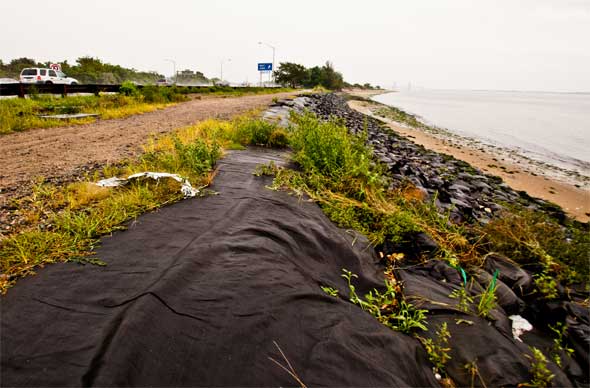City Abandons Plumb Beach Ahead Of Hurricane, Puts Belt Parkway At Risk

It was less than two years ago that another hurricane beginning with the letter “I” battered Plumb Beach, obliterating a section of it and making vulnerable an exposed strip of the Belt Parkway to future flooding. Now it appears the city has failed to learn its lesson, and no preparations have been made in advance of Hurricane Irene.
With Hurricane Irene expected to make landfall on Sunday, no additional sandbags have been added to the Plumb Beach shoreline – posing a unique danger to residents because of existing erosion and its proximity to the Belt Parkway. In its current condition, one relatively strong storm could be successful in washing away a major transportation artery. As the photo above shows, the existing sandbags have slipped backward towards the waters, weakening its role as a potential barrier between the waters and the highway.
Meanwhile, the various agencies that oversee the strip of land – a hodgepodge of federal, state and city jurisdictions – are pointing fingers at each other.
The Army Corps of Engineers, which is overseeing long-term repairs to erosion issues on the beach, said that theirs is a supportive role. Any instructions would have to come from the city, especially in terms of emergency management.
“If there were any preperation being done regarding that, that would be the city. Specifically Parks Department,” said spokesperson Chris Gardner.
The National Parks Service – which oversees federal parkland, including Gateway National Recreational Area, which Plumb Beach is a part of – also said it’s the city’s responsibility.
“[Parks Department] placed the sandbags at Plumb Beach and it is also the local sponsor of the beach reclamation project with the US Army Corps of Engineers,” said National Parks’ Gateway spokesperson John Warren. “Gateway is a partner to this project but not the main force.”
However, the city Parks Department is absolving itself of any responsibility, saying that protecting the beach is not their job.
“The beach isn’t really our jurisdiction, it’s the National Parks Service. We just assisted with the sandbags in the last storm effort,” said spokesperson Phil Abramson.
He added that the current sandbags should hold up in case Hurricane Irene makes landfall.
“The sandbags are still intact,” said Abramson. “There were heavy rains earlier this month and it didn’t seem like that was really a problem. There were other low-lying areas of the Belt that were submerged, but not over there.”
Almost all of the agencies Sheepshead Bites spoke to noted that the overall preparations for the hurricane are being managed by the Office of Emergency Management. That agency, however, appears to be in the dark about the threat at Plumb Beach.
“We haven’t heard of anything [regarding Plumb Beach] at this time but we will be having a briefing [on overall response needs] early this afternoon or this evening,” said an OEM press officer. When asked about the risk of flooding on the Belt Parkway, and the dangers that could pose in evacuation, the press officer said, “Look, I don’t have any more information. My phone is ringing off the hook,” and hung up on us.
A staffer for a local city councilman, however, sat in on OEM’s afternoon meeting and said that Plumb Beach was never mentioned – nor was any other neighborhood.
“They didn’t really get into individual neighborhoods specifically. No, there was no mention of Plumb Beach, but there was no mention of any particular neighborhood in the city,” said Bryan Lee, the staffer for Councilman Lew Fidler. “They didn’t speak specifically about any one roadway, the Belt Parkway or the others.”
The idea that the city would repeat the problems that saw Plumb Beach unprepared in 2009, when Hurricane Ida struck it, has Fidler astounded.
“People who don’t learn from their past are condemned to repeat it. Both Plumb Beach and Seagate are clearly susceptible,” Fidler said. “I have to hope and pray that there is a detail in the plan that addresses areas that get habitual flooding. I would find it completely shocking if they didn’t.”
After receiving a call from Sheepshead Bites, Fidler’s office contacted the OEM to urge them to pay additional attention to the area in light of previous damage. According to the councilman’s office, the agency said “neigbhorhoods throughout the city are requesting sandbags and they’re not really going neighborhood to neighborhood doing that.”
When the remnants of Hurricane Ida struck Plumb Beach in 2009, it washed away a 2000-foot-long section of sand and vegetation, and barreled into the adjacent bikeway, sweeping much of it out to see. Storms that followed, including one in March 2010, furthered the erosion, putting waters and the Belt Parkway just spitting distance apart.
Those storms never exceeded winds of 70 mph as they made landfall in the area, but current government projections for Hurricane Irene show the eye going straight over western Long Island with wind speeds between 73 and 110 mph.
While all of the agencies are going over general priorities at the urging of OEM – such as clearing catch basins (DEP), securing loose objects like garbage cans on the beaches (Parks), and locking down loose parts on bridges (DOT) – local problem spots are going ignored.
None of this would’ve been a problem had jurisdictional squabbling not halted restoration efforts for two years since the last storm, according to one local leader.
“You cannot wait for the event to be imminent to go ‘Oh, you shouldve done something.’ No. Something should’ve been done already,” said Community Board 15 Chairperson Theresa Scavo. “This should’ve been resolved a long time ago, not wait until now.”




